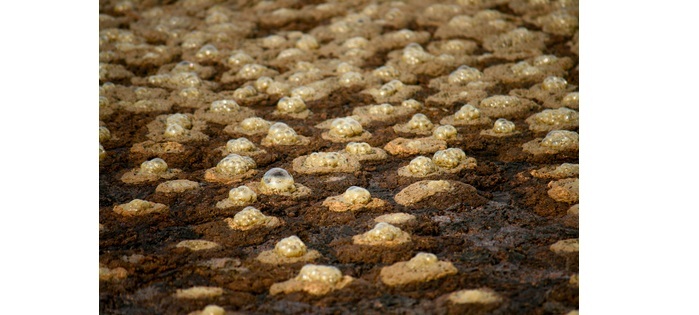
 Data Structure
Data Structure Networking
Networking RDBMS
RDBMS Operating System
Operating System Java
Java MS Excel
MS Excel iOS
iOS HTML
HTML CSS
CSS Android
Android Python
Python C Programming
C Programming C++
C++ C#
C# MongoDB
MongoDB MySQL
MySQL Javascript
Javascript PHP
PHP
- Selected Reading
- UPSC IAS Exams Notes
- Developer's Best Practices
- Questions and Answers
- Effective Resume Writing
- HR Interview Questions
- Computer Glossary
- Who is Who
Environmental Biotechnology: An Overview
Introduction
Environmental biotechnology is biotechnology that is used to understand the environment and is applied to it. Environmental biotechnology may also suggest that one tries to control biological processes for profit.
Environmental biotechnology is described as "the development, use, and regulation of biological systems for remediation of contaminated environments (land, air, and water), and for environment-friendly processes (green manufacturing technologies and sustainable development)" by the International Society for Environmental Biotechnology.
Definition
The simplest definition of environmental biotechnology is "the best use of nature, in the form of plants, animals, bacteria, fungi, and algae, to produce renewable energy, food, and nutrients in a synergistic integrated cycle of profitable processes where the waste of each process becomes the feedstock for another process."

Impact of Environmental Biotechnology
Small Scale Agro-Ecological Agriculture: In order to attain food security, climate change mitigation, climate change adaptation, and the realization of the Millennium Development Goals, the IAASTD has urged for the promotion of small-scale agro-ecological agricultural systems and technology.
Bio Gas: Zero waste agriculture and, most notably, the operation of more than 15 million biogas digesters around the world have both been shown [citation needed] to be substantial contributions of environmental biotechnology to agroecology.
Clean the Oil Spills: Microbes isolated from oil-rich habitats, such as oil wells, oil transfer pipelines, etc., have been found to have the capacity to break down oil or utilise it as a source of energy in marine oil spills that need to be cleaned up. They thereby help to clean up oil spills.
-
Pollution Control: Consider the effluents from a starch plant that have gotten into a lake or pond close by. Large starch deposits exist, but with a few notable exceptions, bacteria are not able to oxidise them quickly. The bacteria from the contaminated site are analysed for genetic changes that give them the ability to degrade/use starch more efficiently than other microbes in their genus.
Then, the changed genes are discovered. The resultant genes are used for economically favourable activities, such as fermentations in the pharmaceutical industry, and cloned into industrially significant microorganisms.
Pollution Prevention: On the other hand, these recently introduced microbes might upset the ecology in question. It may be necessary to change the mutual harmony that existed between the creatures in that particular habitat, therefore we must take great care to avoid upsetting the already-existing mutual interactions between the advantages and downsides of environmental biotechnology.

Applications
By selective breeding and contemporary genetic manipulation, humans have long modified genetic material to improve crop productivity, among other things. There may also be unanticipated, detrimental effects on one's health and the environment. Environmental biotechnology aims to strike a balance between the implications of genetic material manipulation and the applications that make them possible.
Both the applications and the implications are covered in textbooks. Environmental biotechnology texts are now frequently regarded as environmental engineering texts that deal with sewage treatment and biological concepts. They often cover biotechnology uses, although the ramifications of these technologies are covered less frequently; typically in works that cover potential effects and potentially catastrophic situations.
Bioremediation
It refers to any technique that uses a live or dead biological system to remove environmental contaminants from air, water, soil, flue gases, industrial effluents, etc. in natural or artificial settings (usually bacteria, microalgae, fungi, and plants). The use of biological resources in the treatment of contaminated environments has been drawn to the inherent capacity of organisms to adsorb, collect, and degrade common and new contaminants.
Biotransformation
The biological change of a single chemical compound or a combination of chemical components is known as biotransformation. Whether using single cells, their lysates, or pure enzymes, biotransformation could be carried out. Progressively, pure enzymes are used to carry out biotransformation. Biotransformations are essential to numerous industries and life-saving technologies.
Biomarkers
Biological molecule that can be detected in tissues, body fluids, or blood and is a symptom of a condition, disease, or a normal or pathological effect is called biomarker. To determine how well the body's response to a disease or disease treatment, a biomarker may be utilized. It is also known as a signature molecule and a molecular marker.
Biofuel
Fuel made from biomass, or any plant, algae, or animal waste. Unlike to fossil fuels like petroleum, coal, and natural gas, biofuel is seen as a source of renewable energy due to the ease with which such feedstock material may be supplied.
Biosensors
A biosensor is an analytical tool that combines a biological element with a physicochemical detector and is used to identify chemicals. The sensitive biological element is a biologically derived substance or biomimetic component that interacts with, binds to, or recognizes the analyte under investigation. Examples include tissue, bacteria, organelles, cell receptors, enzymes, antibodies, nucleic acids, etc.

Molecular Ecology
figuring out population hybridization and gene flow using microsatellites. The use of DNA microarrays, which enables the simultaneous investigation of the expression of thousands of distinct genes, is also directly tied to the advancement of molecular ecology. Quantitative PCR can also be used to examine how changes in the environment or variations in how differently adapted people react affect gene expression.
Bio mining
In the process of biomining, microorganisms (microbes) are used to extract valuable metals from rock ores or mine waste. Moreover, locations that have been contaminated with metals may be cleaned up using biomining techniques.
Outcome of Applications
Achievements of Department of Environmental Biotechnology (India)
Endosulfan risk assessment research was conducted using in vitro cell models. Results have led to the discovery of biological signs of endosulfan toxicity that have undergone thorough validation.
In the Karanataka region's Malenad-Mysore ecosystem, insights into the meta-population dynamics (population dynamics, spatial ecology, conservation & management) of Tigers and other Carnivores have been achieved.
Six microbial isolates were found, and they demonstrated good efficiency and a quicker doubling time in the breakdown of the pesticides CP (Chlor-pyrifos) and TCP (Tri-Chloro-Pyridinol). These isolates may make excellent for a microbial consortium to build for the breakdown of pesticides.
An extensive contribution has been made to conservation, plant taxonomy, herbarium construction, field germplasm bank establishment, and improved conservation status as a result of the Pan India Network Project on Conservation of Threatened Plants of India. The February 2018 issues of Current Science Journal included a special section devoted solely to the program's results.

